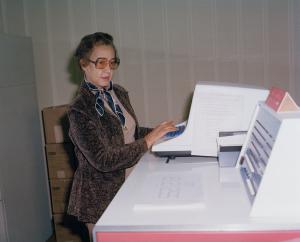Breaking Through Gender Roles

During the 1950s and 1960s the space race was a very vital part of the Cold War. After Sputnik was successfully launched by the Soviets, the United States federal government allocated large sums of money to advance space travel technology. NASA (National Aeronautics and Space Administration) was conceived in 1958 from the previous NACA (National Advisory Committee for Aeronautics) as an independent agency of the United States Federal Government. NASA was responsible for the civilian space program, as well as continual advancement of aeronautics and aerospace research.
During this time three women broke through massive employment barriers in the fields of mathematics and computer science. These women defied expectations and broke barriers for both women and African Americans creating momentum for change in the field of aeronautics.
Students will explore the life of each of these women and identify and analyze their key contributions to the field of aeronautics.
- 60 minutes
- Students will use three essential themes to analyze and discuss both verbally and in writing how their subject had impact as an agent of change.
- Working both collaboratively and individually, students will reflect, analyze, and synthesize significant information taken from the assigned website biographies summaries of their figure’s life and achievements. Students will demonstrate an understanding of three essential themes, Defying Expectations, Breaking Barriers, or Creating Momentum for Change, by identifying ways these achievements impacted society.
- Either individually or as a group, students will present and support their decision in a cohesive and factual statement (Thank You Letter) using information and knowledge gained from their research and class discussion.
-
General knowledge of the Cold War and how the space race between the United States and the USSR was a proxy of the conflict.
Readings: Computer/IPAD
- Katherine Johnson:
- Dorothy Vaughan: https://www.nasa.gov/langley/hall-of-honor/dorothy-j-vaughan
- Mary Jackson: https://www.nasa.gov/image-feature/mary-jackson-a-life-of-service-and-a-love-of-science
Handouts:
Warm-up (7 minutes):
- Students will work independently to answer the three warm up questions. (3 minutes)
- Teacher will lead a brief discussion going over the students’ responses. (5 minutes)
Video Background (10 minutes): The Cold War Extends to Space (History.com)
https://www.history.com/topics/cold-war/cold-war-history
- Students will watch the 2:58 video.
- Students will be instructed to write down three (3) new facts they learned from viewing the video. Space is provided at the bottom of the Warm-up handout.
- Teacher will instruct the students to pair-share their facts with one other student. (3 minutes)
- Teacher will lead a brief discussion inviting students to share interesting facts that were learned. (4 minutes)
Student Activity: Women of NASA (25 minutes)
- Students will move into groups of three.
- Each student will be assigned one of the women listed on the Breaking Through Gender Roles: The Women of NASA Graphic Organizer to research on the NASA website (see links above). (7 minutes)
- Students will then exchange their researched information with each other, so that every student has the graphic organizer completed. (10 minutes) (Hint: the teacher should keep time and give each student 2 minutes to share and then move on to the next student and then the final student)
- Teacher will wrap-up the activity leading an exploratory discussion based on the Question for Understanding. The teacher will ask students to share out important facts they researched to help them answer the two questions. (8 minutes)
Extension Activity: Thank You Letter (15 minutes)
- Students will choose one of the Women of NASA and write them a thank you letter.
- Teacher will role-model a proper letter format for the students on the board/whiteboard.
Students will be required to be specific in explaining why they are thankful for their figure’s achievements and present a clear understanding of the impact that those achievements had on defying the expectations of society and breaking through gender barriers to creating momentum for change.
Thank You Letter (students who do not finish in the time provided in class will be required to finish it for homework.)
C3 Framework Standards:
D2.His.1.6-8. Analyze connections among events and developments in broader historical contexts.
D2.His.2.6-8. Classify series of historical events and developments as examples of change and/or continuity.
D2.His.3.6-8. Use questions generated about individuals and groups to analyze why they, and the developments they shaped, are seen as historically significant.
D2.His.15.6-8. Evaluate the relative influence of various causes of events and developments in the past.
D4.2.6-8. Construct explanations using reasoning, correct sequence, examples, and details with relevant information and data, while acknowledging the strengths and weaknesses of the explanations.
Common Core Standards:
CCSS.ELA-LITERACY.RI.8.1: Cite the textual evidence that most strongly supports an analysis of what the text says explicitly as well as inferences drawn from the text.
CCSS.ELA-LITERACY.RI.8.2: Determine a central idea of a text and analyze its development over the course of the text, including its relationship to supporting ideas; provide an objective summary of the text.
CCSS.ELA-LITERACY.SL.8.4: Present claims and findings, emphasizing salient points in a focused, coherent manner with relevant evidence, sound valid reasoning, and well-chosen details; use appropriate eye contact, adequate volume, and clear pronunciation.
CCSS.ELA-LITERACY.RH.6-8.1: Cite specific textual evidence to support analysis of primary and secondary sources.
CCSS.ELA-LITERACY.RH.6-8.2: Determine the central ideas or information of a primary or secondary source; provide an accurate summary of the source distinct from prior knowledge or opinions.
CCSS.ELA-LITERACY.RH.6-8.3: Identify key steps in a text's description of a process related to history/social studies (e.g., how a bill becomes law, how interest rates are raised or lowered).
CCSS.ELA-LITERACY.WHST.6-8.1.D: Establish and maintain a formal style.
CCSS.ELA-LITERACY.WHST.6-8.1.E: Provide a concluding statement or section that follows from and supports the argument presented.
CCSS.ELA-LITERACY.WHST.6-8.4: Produce clear and coherent writing in which the development, organization, and style are appropriate to task, purpose, and audience.
